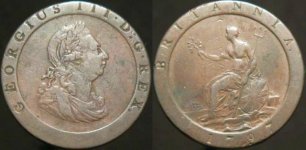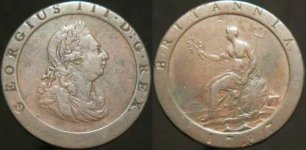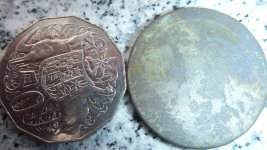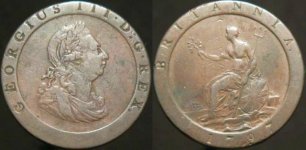AussieMike
Tenderfoot
Hi from Australia all, I found this about 4 weeks ago and has sat on my kitchen bench since very lucky to avoid me discarding into the bin many times. Luckily a fellow member from an oz forum posted a pic of one he found and I instantly recognised as what I had. It is one very worn ugly piece of copper but never the less it is a cartwheel penny sweeet  and my best find to date.You can just make out the (9) from 1797 at bottom right. Love this site and reading about all the intresting things you guys and gals find over there.
and my best find to date.You can just make out the (9) from 1797 at bottom right. Love this site and reading about all the intresting things you guys and gals find over there.
British penny, 1797 (Cartwheel penny)
This is an example of the 1797 British penny, which became the first official Australian coin after a shipment arrived in Sydney in 1800. The coins in this shipment were given a local value of two pence by a proclamation of the Governor. The coins remained in use for some 60 years and found their way to Melbourne in the 1830s and 1840s. Examples found in archaeological excavations can be seen in the Melbourne exhibition. The coins were made in Birmingham by Matthew Boulton on presses driven by James Watt's new steam engine. It was the first use of the new engine.
Proclamation 1797 Cartwheel Penny
In my previous entry about Australian proclamation coins I mentioned the 1797 cartwheel penny of Great Britain which was valued at 2d in the proclamation. These large (36mm diameter) copper coins were struck in copper in the years 1797 to 1799. Their large distinctive raised rims were reminiscent of cartwheels and they were nicknamed accordingly. The cartwheel penny and twopence were the first coins minted anywhere in the world using steam powered coin presses, and this new technology allowed the mass production of a well struck yet very large coin. The coins themselves weighed exactly 1 ounce (avoirdupois) or 28.35g. This was intentional and allowed the coins (and their 2 penny brethren which weighed 2oz) to be used as weights for scales.
The coins were minted at the Soho mint (the mint mark is visible on the reverse) in Birmingham. The mint itself was setup by Matthew Boulton, the well known 18th factory owner and manufacturer. His mint used steam powered coin presses, with the steam engines designed and manufactured with his business partner and steam engine pioneer James Watt.
The obverse of the coin depicts a laureate bust of King George III facing right. The unusual incuse legend in the cartwheel rim reads Georgius III D.G. REX. This translates to George III, by the grace of God, King.
The reverse of the coin depicts robed and seated Britannia facing left holding a trident. She is depicted on a back drop of the ocean with a ship at the bottom left, this symbolized Britains naval might and reliance on sea trade at the time of the striking of the coins. The mint mark SOHO can be seen in small incuse letters just below the figure of Britannia in the exergue. The incuse legend in the rims reads Britannia 1797.
A key problem with purchasing these coins is the sheer size and weight of the coin. This can lead to significant rim bruising that (if possible) should be avoided when purchasing a coin. That being said attractive mid grade coins are readily available at reasonable cost. Higher grade coins (extremely fine and above) are obtainable if you are willing to wait for a coin to appear. Interestingly proof specimens of the cartwheel penny are available in straight copper, gilded, and bronzed copper. These are stunningly attractive coins but priced accordingly!
 and my best find to date.You can just make out the (9) from 1797 at bottom right. Love this site and reading about all the intresting things you guys and gals find over there.
and my best find to date.You can just make out the (9) from 1797 at bottom right. Love this site and reading about all the intresting things you guys and gals find over there.British penny, 1797 (Cartwheel penny)
This is an example of the 1797 British penny, which became the first official Australian coin after a shipment arrived in Sydney in 1800. The coins in this shipment were given a local value of two pence by a proclamation of the Governor. The coins remained in use for some 60 years and found their way to Melbourne in the 1830s and 1840s. Examples found in archaeological excavations can be seen in the Melbourne exhibition. The coins were made in Birmingham by Matthew Boulton on presses driven by James Watt's new steam engine. It was the first use of the new engine.
Proclamation 1797 Cartwheel Penny
In my previous entry about Australian proclamation coins I mentioned the 1797 cartwheel penny of Great Britain which was valued at 2d in the proclamation. These large (36mm diameter) copper coins were struck in copper in the years 1797 to 1799. Their large distinctive raised rims were reminiscent of cartwheels and they were nicknamed accordingly. The cartwheel penny and twopence were the first coins minted anywhere in the world using steam powered coin presses, and this new technology allowed the mass production of a well struck yet very large coin. The coins themselves weighed exactly 1 ounce (avoirdupois) or 28.35g. This was intentional and allowed the coins (and their 2 penny brethren which weighed 2oz) to be used as weights for scales.
The coins were minted at the Soho mint (the mint mark is visible on the reverse) in Birmingham. The mint itself was setup by Matthew Boulton, the well known 18th factory owner and manufacturer. His mint used steam powered coin presses, with the steam engines designed and manufactured with his business partner and steam engine pioneer James Watt.
The obverse of the coin depicts a laureate bust of King George III facing right. The unusual incuse legend in the cartwheel rim reads Georgius III D.G. REX. This translates to George III, by the grace of God, King.
The reverse of the coin depicts robed and seated Britannia facing left holding a trident. She is depicted on a back drop of the ocean with a ship at the bottom left, this symbolized Britains naval might and reliance on sea trade at the time of the striking of the coins. The mint mark SOHO can be seen in small incuse letters just below the figure of Britannia in the exergue. The incuse legend in the rims reads Britannia 1797.
A key problem with purchasing these coins is the sheer size and weight of the coin. This can lead to significant rim bruising that (if possible) should be avoided when purchasing a coin. That being said attractive mid grade coins are readily available at reasonable cost. Higher grade coins (extremely fine and above) are obtainable if you are willing to wait for a coin to appear. Interestingly proof specimens of the cartwheel penny are available in straight copper, gilded, and bronzed copper. These are stunningly attractive coins but priced accordingly!
Attachments
Upvote
0






 up for a correct ID on the Cartwheel and the willingness to make sure it's correct. Unlike people who are confused calling a common token a counterfeit gold coin, or a dump issue Halfpenny a Farthing, then have the audacity to suggest their knowledge is superior and shun the correct answers. Anyway, I'm glad that's not you!
up for a correct ID on the Cartwheel and the willingness to make sure it's correct. Unlike people who are confused calling a common token a counterfeit gold coin, or a dump issue Halfpenny a Farthing, then have the audacity to suggest their knowledge is superior and shun the correct answers. Anyway, I'm glad that's not you!







